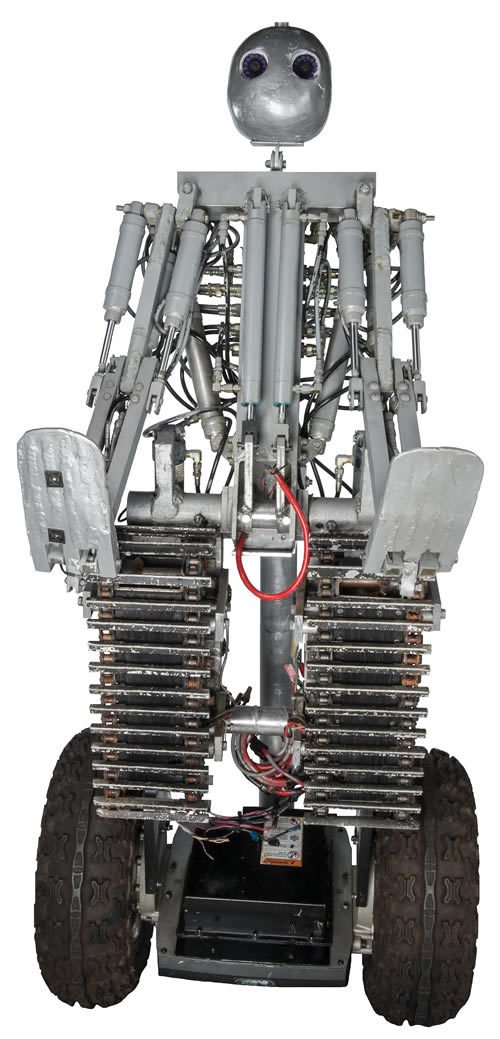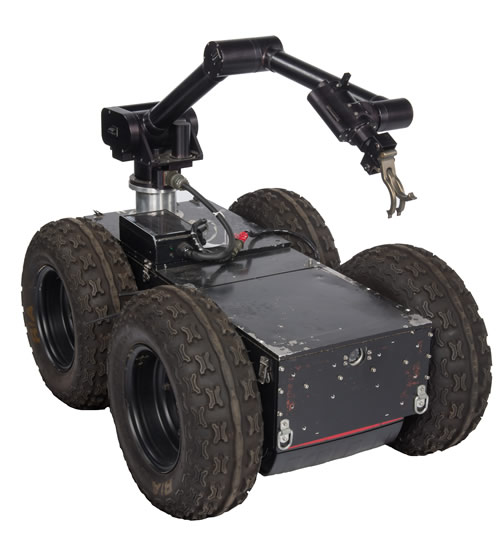National Museum of Health and Medicine Acquires Prototype Casualty Evacuation Robots
By Lauren Bigge
NMHM Public Affairs Coordinator
The National Museum of Health and Medicine (NMHM) recently acquired two prototype casualty evacuation robots transferred to the museum from the Telemedicine and Advanced Technology Research Center (TATRC), the advanced technology wing of the U.S. Army's Medical Research and Materiel Command (USAMRMC) at Fort Detrick, Maryland.
The Battlefield Extraction-Assist Robot (BEAR) prototype robot was strong enough to haul up to 500 pounds and could use its hydraulic arms to pick up a wounded service member in a war zone. The robot moved on wheels for flat terrains, and on tracked "legs" for rough terrain, to transport a casualty to a location where a combat medic could safely conduct an initial assessment.
NMHM, a Department of Defense museum, received the BEAR prototype in 2017, along with another very early research prototype, a casualty evacuation robot known as ARES. This type of technological development demonstrates the U.S. military's interest in researching the application of emerging technologies toward future capabilities that could rescue service members injured on the battlefield without risking additional lives in the process. NMHM collects representative examples of such technological developments to place those new advances alongside historical examples in order to track innovation in fields such as medical evacuation or battlefield care, and to facilitate access by researchers and other advanced developers.
Researchers at TATRC oversaw development of BEAR and ARES as part of the agency's focus on the concept of automated rescue.
Alan Hawk, who manages NMHM's historical collections, has collaborated with TATRC for many years, keeping abreast of their developments. "They look for unusual and radical solutions to solve medical problems," Hawk said.
BEAR's cameras and microphone allowed the robot to be remotely controlled, using a motion-capture glove or specially-equipped rifle grip. Soldiers at the U.S. Army Infantry Center Maneuver Battle Lab at Fort Benning, Ga. tested the robot in 2009 and 2010. The tests were to determine if the robot could accomplish more tasks with fewer risks, because not every task requires a trained human medic.
The ARES robot is a proof-of-concept unmanned ground vehicle, tested in 2008 and 2009, based on a predecessor robot that was designed for explosive-ordnance disposal. ARES could haul 200 pounds, traveled as fast as 15 miles per hour for up to 10 miles, and was built on top of the Segway RMP-400™ mobility platform with advanced electronics, wireless communications, computing and control technologies. ARES configurations had varying payloads, such as manipulator arms and sensors for different research applications. Its hook was capable of grabbing a severely wounded service member's body armor handle and dragging the casualty out of harm's way.
"These robots were developed for research purposes to demonstrate the "art of the possible" in terms of applying emerging robotics technology to applications like extracting the wounded from the battlefield," said Nathan T. Fisher, project manager of Medical Robotics and Autonomous Systems at USAMRMC's TATRC, which transferred the prototypes to NMHM. "We don't have a current iteration of the BEAR or ARES robots. Our current research has been more focused on how to adapt emerging multi-role robotic platforms to augment medical capabilities, as opposed to designing robotic platforms specifically for medical roles."
BEAR and ARES are the latest additions to NMHM's collections documenting the history of automated medical care for service members immediately after injury. In 2001, the museum acquired the mobile robotic courier system called HelpMate (named "Emilie" by Walter Reed Army Medical Center, to honor Major Walter Reed's daughter Emilie Reed), and in 2017, acquired the prototype of the APPRAISE system, which is used for analyzing patient vital sign data during pre-hospital transport and sending results about patterns associated with life-threatening hemorrhage ahead to trauma centers. NMHM continues to acquire service member care-related technologies as they become available.
NMHM is an element of the Defense Health Agency-Research and Acquisition Directorate. Learn more about NMHM online at www.medicalmuseum.mil.





